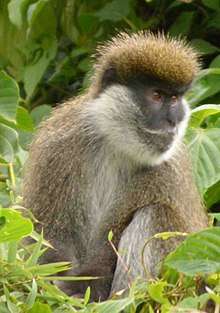Bale Mountains vervet
The Bale Mountains vervet (Chlorocebus djamdjamensis) is a terrestrial Old World monkey endemic to Ethiopia, found in the bamboo forests of the Bale Mountains.[1][2] It was originally described as a subspecies of the grivet (Chlorocebus aethiops).[1] All species in Chlorocebus were formerly in the genus Cercopithecus.[1] The Bale Mountains Vervet is one of the least known primates in Africa. The Bale Mountains Vervet avoid tree-dominated and bush land areas as their habitat. These monkeys mainly reside in the bamboo forest (Odubullu Forest) of the Bale mountain due their dietary specialization on bamboo, however, other factors such as climate, forest history, soil quality, and disease could are likely to play a role in their choice to inhibit this area. The Bale Mountains Vervet have a very quiet behavior and tend to flee when coming across a human being.[3]
| Bale Mountains vervet[1] | |
|---|---|
 | |
| A Bale Mountains vervet, Chlorocebus djamdjamensis, near Rira, Ethiopia | |
| Scientific classification | |
| Kingdom: | Animalia |
| Phylum: | Chordata |
| Class: | Mammalia |
| Order: | Primates |
| Suborder: | Haplorhini |
| Infraorder: | Simiiformes |
| Family: | Cercopithecidae |
| Genus: | Chlorocebus |
| Species: | C. djamdjamensis |
| Binomial name | |
| Chlorocebus djamdjamensis Neumann, 1902 | |
 | |
| Bale Mountains vervet range | |
References
- Groves, C. P. (2005). Wilson, D. E.; Reeder, D. M. (eds.). Mammal Species of the World: A Taxonomic and Geographic Reference (3rd ed.). Baltimore: Johns Hopkins University Press. p. 159. ISBN 0-801-88221-4. OCLC 62265494.
- Butynski, T. M.; Gippoliti, S.; Kingdon, J. & De Jong, Y. (2008). "Chlorocebus djamdjamensis". IUCN Red List of Threatened Species. 2008: e.T4240A10699069. doi:10.2305/IUCN.UK.2008.RLTS.T4240A10699069.en.
- Mekonnen, Addisu; Bekele, Afework; Hemson, Graham; Teshome, Eyob; Atickem, Anagaw (October 2010). "Population size and habitat preference of the Vulnerable Bale monkey Chlorocebus djamdjamensis in Odobullu Forest and its distribution across the Bale Mountains, Ethiopia". Oryx. 44 (4): 558–563. doi:10.1017/s0030605310000748. ISSN 0030-6053.
This is one of the least researched primate.
